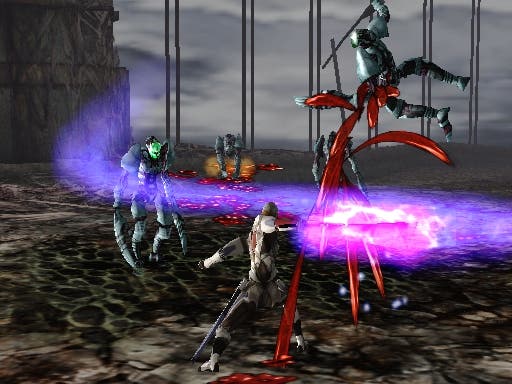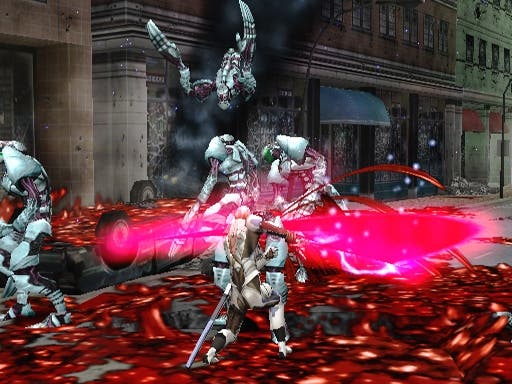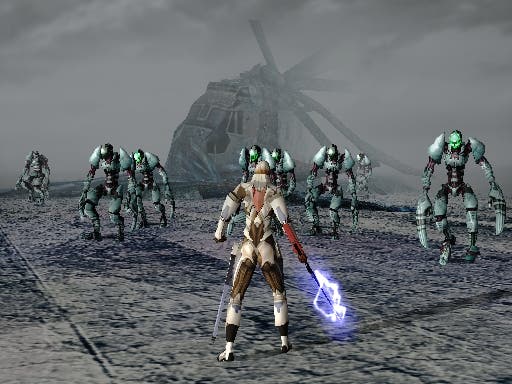Nanobreaker
A game about microscopic creatures that replicate inside living tissue and then destroy everything except the useful bits. They'd take this whole game down, frankly.
Order yours now from Simply Games.

Manhunt was psychotic. Actually literally. Rather naughtily, it had you lurk in the shadows hesitantly, heaping on the tension by refusing (mechanically) to show you the whole threat, and then letting you drain the pressure at intervals through brutal, gruesome fell swoops that through their close-up framing and unpleasantly squishy sound effects gave the lie to any claim that it was about the play experience rather than the experience of, you know, carving people up. It was a murder sim, really, and a pretty morose one at that.
Nanobreaker manages a similar trick. As you play through, a meter in the bottom right of the screen tots up the gallons of blood that you've spilt through your hacking and slashing, and rewards you with power-ups at intervals of 2,000 gallons - all the while fountains of lumpy gore stream forth from the wounds, arm-stumps and squirming severed torsos of your alien-esque adversaries. Like Manhunt, the on-screen ultraviolence is accompanied by a sense of festering malevolence that's hard to shake. Fortunately for Konami though, the Daily Mail probably won't give a flying gib this time around - the bloodstained mental anguish here has more to do with a ceaseless cavalcade of appalling design decisions that left us wondering whether it wasn't some sort of joke-game designed to highlight all the very worst things that we've learnt to avoid in third-person action games over the past two generations of console hardware.
We're tempted to borrow one of Manhunt's hatchets before we go any further.
We're also tempted to do a joke about how this review is a better way to experience Nanobreaker than owning the game itself. How you should give us £40 instead. But that would probably be too much too soon.

The story is a clichéd, underdeveloped mess, but the cut-scenes that tell it are actually among the most enjoyable bits of the game - largely on account of the fact that you can ignore them, whereas the rest of the game requires active participation. The set-up is thus: through some sort of joint initiative, the powers-that-be have gathered all the foremost people in various scientific and technological fields and planted them on an island where they've been set to work developing nanotechnology - i.e. those little microscopic machines that can be used to repair, enhance and whatnot on a very small scale. Unfortunately, as is the way with such things, the central computer controlling them appears to have malfunctioned, sending them into hyper-replication and resulting in the emergence of nasty-looking and sounding Orgamechs, which not only kill people but rip them apart at a molecular level and feed on the iron in their blood. Pleasant. All of this is borne out in graphic detail in the CG sequences.
As is equally typical of such things, with the basic military option more or less exhausted, the now-desperate powers-that-be have sent in a top scientist (a woman. A very annoying woman) to disable the computer, but through some administrative cock-up she's managed to head in on her own. Obviously she needs some help. Clearly realising that things can't get much worse, the man in charge fetches a presumed-dead "cyborg militant" - originally sentenced to death for the genocidal slaughter of countless innocent women and children in amongst his war-mongering - from seven years' deep sleep, equips him with a prototype plasma sword - the only thing that can hurt the monsties, naturally - and packs him off to the disaster area. His name's Jake, he's blonde, he's charmless, he broods, and he looks a bit like Raiden from Metal Gear Solid 2.
All of which begs a few questions. How are we expected to empathise with a man whose main claim to fame is that he managed to get himself mock-executed for slaughtering women and children? (A question so obvious, in fact, that it's virtually the first thing that silly-science-woman asks him when he heroically rescues her from the stupid, gormless AI enemies whose brutal efficiency in the cut-scenes is literally never replicated in-game.) And, moreover, if this plasma sword thing is known to be the only thing that works, why not just FedEx a bunch of them to the poor old "normal" cyborg militants on the front lines who happen to not be noted for their brutal slaughter of women and children? Why let them die and bring Jake The Homewrecker back from the dead? None of it makes any sense.
Another question that arises soon after, just as you're pondering whether the script and voice acting can get much more tiring and pointless, is why in this futuristic world of cyborg men with mini-guns in their arms and nano-kill-bots would anybody dream of having the central protagonist's arch-nemesis go by the name of Keith?

No matter. Once all that's established, the game kicks off and quickly settles into a predictable rhythm. Boring enemies who looked so powerful and menacing in the cut-scenes spawn out of thin air and walk very slowly toward you, occasionally poking you with an arm, and you use a mixture of horizontal (square) and vertical (triangle) slashes to rip them to shreds, using a single modifier (R1) to change your type of attack, and varying button combinations to combo, juggle and generally improve your rate of slaughter. Once you've killed enough of them, a sort of laser barrier will fall and you'll move on a bit, face another array of enemies, kill them, and move on again. Maybe you'll go into another room. None of this is fun.
Environments, to get the "graphics" bit of the review out of the way, are brown or grey. Not all the colours are brown or grey, obviously, but the ones that aren't have been hanging around the browns and the greys so long that they all speak with the same dull accent and look like they couldn't be bothered to put all their polygons on in the morning. Everything is deeply dull to look at. And yet, in spite of that, not only do the enemies keep up this "look rubbish" mandate, but the draw distance is appalling and there's regular slowdown too.
Every so often you get to fight a boss - the first of these is a giant Venus Flytrap with some really basic attack patterns and a tediously long health bar, and pretty much all the bosses are like this. Most of them stick to one or two specific attacks, which are pretty easy to undo once you've identified them, and as a group they help underline some of the most niggling frustrations the game has to serve up. For example, the way you cannot interrupt attack animations, so even if an enemy has a highly visible and obvious wind-up prior to launching its most devastating attack, the chances are you won't be able to avoid it with your jump (X) or dodge-roll (R1 plus X) because Jake can't break out of whatever ineffective attack he's currently unloading. They also help show off the way that the game's just so oblique about the way it instructs you, often ruining what minor suspension of disbelief you may be clinging onto by telling you, for example, to finish an encounter with a particular new move, but not then adequately explaining that it wants you to hit R1 plus square and then hit triangle, all of which leaves you to sit there hammering buttons confusedly while the boss stands motionless waiting to be killed.
Bosses subsequent to the plant-flapper highlight more of these failings - like the squirrelly feeling of the controls with no obvious analogue movement, the way you cannot centre the camera, the way the camera moves too slowly and bobs around, the inconsistency of the collision detection, and - perhaps most frustrating of all - the dev team's mad insistence on sandwiching a tedious and worryingly simplistic hackandslash "kill all the enemies in the area" bit between the pre-boss save marker and the boss fight itself, meaning that whenever you come undone facing off against a boss you'll be forced to replay the utterly unchallenging section preceding it as punishment. Cleverly, there are even occasions when the post-boss save marker is visible prior to the boss fight, but unreachable. It's this kind of concentrated stupidity that makes Nanobreaker so special.

Want another example? Okay. The entire game is predicated on the idea of a clever melee combat system. You can morph your plasma sword into various other weapons, and you can pick up combo "chips" and plug them in to different bits of combo screen to give Jake access to different attacks depending on your mood. In order to undermine this to a degree consistent with the rest of the game's failings, the designers decided that the weapon-morph bits would be so unnoticeable that it took us fully half an hour to realise were already doing one as we stood there repeating the button combo ad infinitum. Better, you don't even have to use the combat system, because amongst Jake's other abilities is (in fact, sorry, that should read "because Jake's other ability is") a lasso technique that lets him reel enemies in, Scorpion-in-Mortal-Kombat-style, and kill them with one hit. Just by pressing square or triangle at the right time. With practice, you can kill virtually every enemy in the game - save for the bosses - using this one technique. And as if that wasn't silly enough, the timing for the lasso-kill actually gets easier as you receive power-ups.
Given the ease of progression through fight sequences (even if you can't lasso-kill, you can always use the square-triangle-square spinny-attack to clear crowds around you endlessly), it's actually something of a surprise that the game manages to kill you so often. But, rest assured, where the primitive enemies fail with their tactic of standing around looking like really crap plastic toys waiting to be killed, where your inability to see what's going on doesn't quite impede you enough, and where the dodgy nature of everything from the collision detection to the lasso-aiming doesn't scupper you, you can at least rely on rubbish platform sections to continually peg you back. It's instant death and back to the spawn point if you fall off. And you will. Because sometimes you can't jump properly, sometimes your momentum from hacking away at the slugs (yes, slugs) carries you off the edge, and all too often you get hit by an unseen projectile from an enemy who wasn't there before you jumped anyway, which naturally has the power to halt you in mid-air and send you tumbling between the two platforms - all because you can't do anything about the laser blasts mid-animation.
Oh, and the only puzzling thing about the puzzles is trying to figure out which attack technique it wants you to apply to which environmental object in a manner you've never before practiced. For example, lassoing the core of a wooden crate to pull it out of the way and unblock a fence - which naturally only works from one particular angle, all the while you're thinking you could just walk or jump round the obstacle anyway were it not for the invisible walls.
We could go on all day, really. There's no end of things wrong with Nanobreaker. It's one of those games that seems to be actively trying to bore or frustrate you at every turn, and it's so charmless and poorly designed that it makes you wonder whether it was just that nobody had the heart to say anything. Only someone with minimal exposure to the genre could overlook its many flaws. It is possible, giving it some thought, that it was just one of those occasions where everyone involved became so close to the project that they couldn't get into the mindset of the hapless impulse-buying consumer and understand the folly of some of their decisions. But frankly that's no excuse. If Manhunt was psychotic, this is the schizophrenic embodiment of everything you could do wrong with a third-person action game.
Order yours now from Simply Games.








